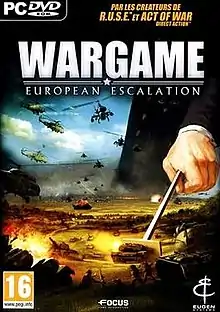Wargame: European Escalation
Wargame: European Escalation is a real-time tactics video game developed by Eugen Systems and published by Focus Home Interactive, released on February 23, 2012. It is set in Europe during the Cold War, most specifically in the years 1975–85 with alternate history scenarios portraying open war between NATO and the Warsaw Pact.
| Wargame: European Escalation | |
|---|---|
 | |
| Developer(s) | Eugen Systems |
| Publisher(s) | Focus Home Interactive |
| Engine | IRISZOOM V? |
| Platform(s) | Microsoft Windows, Mac OS X, Linux, Cloud (OnLive) |
| Release | February 23, 2012 |
| Genre(s) | Real-time tactics |
| Mode(s) | Single player, Multiplayer |
Gameplay
Wargame's playable factions are the Warsaw Pact, which is subdivided into the Soviet Union, Communist Poland, East Germany, and Czechoslovakia; and NATO, which is subdivided into the United States of America, United Kingdom, France, and West Germany. Players can choose various units from the four subfactions of the side they are playing on, unlocking new units or improved variants as they progress. In all, there are 361 historical units recreated in Wargame.
Each country has its own arsenal of units, reflecting their military doctrine.
Solo Mode
Solo mode is divided into four individual campaigns called "Operations", two for each faction. Each are unrelated and chronicle scenarios based on actual events that came close to triggering open war between the two NATO and Warsaw Pact forces.
Reception
| Aggregator | Score |
|---|---|
| Metacritic | 81/100[1] |
| Publication | Score |
|---|---|
| GameSpot | 8.5/10 |
Wargame: European Escalation, has received generally positive reviews upon release, with a Metacritic score of 81/100.[1]
Sequels
On August 10, 2012, a sequel, Wargame: AirLand Battle, was announced with a release scheduled in the spring of 2013. Like its predecessor, it is set in the Cold War period of 1975–85 but focus the NATO–Warsaw Pact war in Northern Europe, notably in Scandinavia, along with the addition of the player's own air force.[2]
Wargame: Red Dragon was announced in 2013 and released in April 2014. Set in the Asian theater of war, it includes units from the 1990s and introduces naval forces.
References
- "Wargame: European Escalation for PC Reviews". Metacritic. CBS Interactive. Retrieved 2020-11-02.
- "Wargame: AirLand Battle unveiled in its first in-game teaser!". Wargame-EE.com. August 8, 2012. Retrieved 2012-11-30.